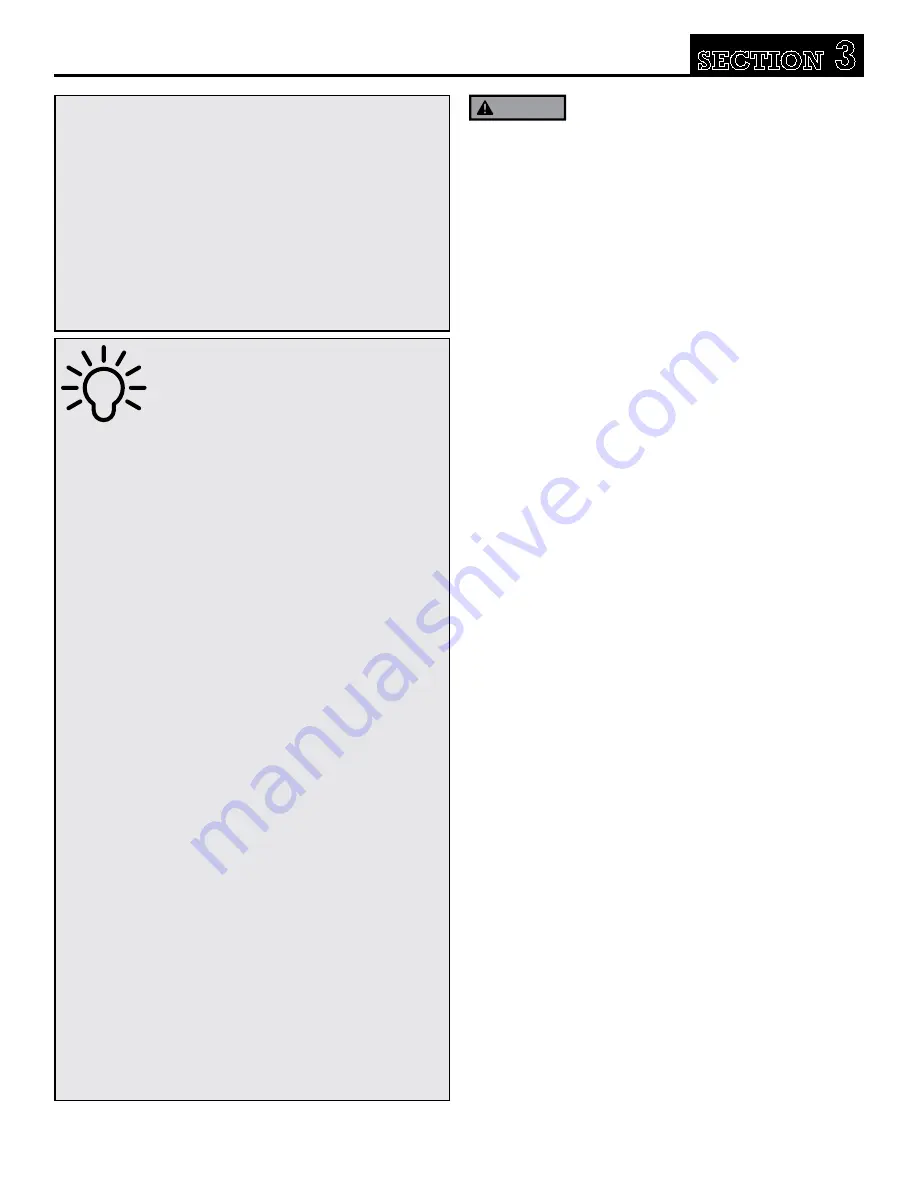
Page 15
Page 15
SECTION
3
Weight, Loading and Towing
DO NOT ANY TYPE OF RACK OR FRAME
TO ANY RECREATIONAL VEHICLE FRAME,
BUMPER, OR CHASSIS PART. THE ALTERATION TO
LENGTH AND/OR WEIGHT DISTRIBUTION MAY RESULT IN
UNSTABLE HANDLING, BE A SAFETY HAZARD, OR COULD
DAMAGE THE RV COMPONENTS. ALTERATIONS OF THIS
SORT, WITHOUT THE RV MANUFACTURERS’ EXPRESS
WRITTEN CONSENT, MAY AFFECT THE RV WARRANTY
HOW TO WEIGH
YOUR RECREATIONAL VEHICLE
• With full fuel tanks and a typical passenger load, weigh the
tow vehicle separate from the trailer.
• Before weighing the trailer, fill the propane tanks. If you
plan to travel with fresh water onboard, the fresh water tank
should also be filled to the level you intend to carry when
traveling.
• Hitch the trailer and weigh both the trailer and the tow
vehicle. Drive onto the scale so that only the tow vehicle
(with full fuel and passengers) is on the scales. This weight
minus the tow vehicle’s weight equals the hitch weight.
• Drive the tow vehicle and the trailer fully onto the scale to
get the Gross Combined Vehicle Weight. This weight minus
the tow vehicle weight equals the trailer weight. The Gross
Vehicle Weight Rating (from the manufacturers’ sticker)
minus the trailers’ weight equals the amount of supplies
and personal gear you can carry.
NOTE:
IF YOU HAVE DUAL AXLES, YOU CAN GET A
WEIGHT FOR EACH AXLE BY STOPPING ON THE SCALE
WITH THE FIRST AXLE ON THE SCALE AND NOTING
THE WEIGHT. THEN DRIVE SO THAT BOTH AXLES ARE
FULLY ON THE SCALE AND NOTE THAT WEIGHT AS
WELL.(WEIGH MASTERS ARE ACCUSTOMED TO THIS
PROCEDURE AND IF YOU EXPLAIN WHAT YOU INTEND
TO DO, WILL USUALLY WORK WITH YOU.)
NOTE:
FOR INFORMATION REGARDING HITCHING TO
THE TOW VEHICLE, PLEASE REFER TO YOUR SELLING
DEALER.
COMPUTING YOUR LOAD
AND LOAD DISTRIBUTION:
To avoid overloading you must understand that the GVWR is
the most weight your unit was designed to carry. The GVWR
is the weight of the entire contents of the unit and the full
weight on the axles on the tongue or hitch. DO NOT EXCEED
THE GVWR OF THIS UNIT. This information is listed on the
“Trailer Weight Information” sticker located on the drivers
side (or road side) front corner of the unit. To determine how
much cargo weight you can put in your unit, make sure the
unit is fairly empty, and all tanks have been drained. Take
LOADING TIPS
(continued)
• Heavy items should be stored close to
the floor in the center of the unit. Avoid
loading heavy items near either end of the
RV or on the rear bumper. Adjust cargo,
as needed, to keep the side to side wheel
loads equal.
• Carry only as much water as needed for
travel use or to balance the load. Empty
your black (waste) and gray (shower and
sinks) tanks before beginning each leg of
your trip.
Bright
Idea
WEIGHING TIPS
• Weights of stored items will vary greatly
and will affect total weight of your
recreational vehicle. Always weigh the
recreational vehicle at a certified weigh
station equipped with platform scales.
• Check the telephone directory or with
local authorities for the location of weigh
stations in your area. If you find that
you have exceeded the GVWR of the
recreational vehicle, you will have to
remove items until you are within the
specified limits. If you find that either of
the GAWR’s has been exceeded you will
need to redistribute the load within the
recreational vehicle to meet the specified
limits. Plan ahead before loading your
RV to insure that items will be evenly
distributed. Not only will the recreational
vehicle handle and ride better, you will
also have reduced tire wear and increased
fuel economy.
• When weighing the recreational vehicle,
weigh both right and left hand sides
separately. This will insure that you have
not overloaded one side or the other,
affecting handling. To avoid possible
damage, DO NOT store heavy items near
the front or rear ends of the RV.
• Empty the holding tanks before leaving
on a trip, and as often as possible when
traveling to help keep weight reduced. Try
to carry only as much water as you will
need while traving. Sometimes, the water
tanks can be used to help balance the
weight in the recreational vehicle (a gallon
of water weighs 8 pounds).
• Secure all items stored inside and outside
the recreational vehicle, and be sure all
doors and drawers are secure.
WARNING
‘WARNING’ indicates a hazardous situation which, if not avoided, could result in death or serious injury.
















































